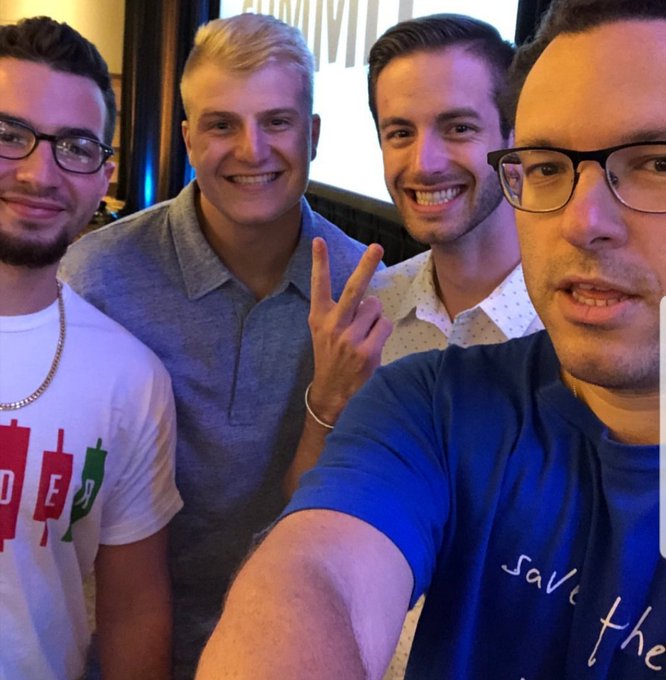In today’s update, we’ll look at a classic penny stock story that can help boost your morale when you’re struggling.
Also in this edition: How to prepare for slippage, when to be encouraged by a losing trade, and how charity can spread when you do it like this…
Table of Contents
Karmagawa, 57 Schools, and Raising Awareness
I’m super proud that through Karmagawa we’ve now opened 57 schools and libraries. We just finished four new schools in Bali.
In September at my annual Trader & Investor Summit conference, we set up a Karmagawa merch stand. I announced that I’d match whatever we raised from sales that weekend. We did roughly $18K in Karmagawa merch sales. I topped it up to $20K with my own money, then matched the $20K.
So, while we were in Bali recently for the openings, we also announced a $40K donation to the Bali Children’s Project.

For all my students who came to the conference — I really appreciate you getting the merch. I’m proud to donate all the money to charity — and happy to give my own money, too.
Please do me — and all the charities we support — a big favor: wear the merch. If you’ve purchased Karmagawa merchandise, please wear it. And please share on social media. It’s important to get the word out.
Profit.ly user SatelliteIncomeUnlimited gets it: I love hearing about the charity work and I love telling my friends and family about it!!
We’re trying to raise money and raise awareness. And it’s working…
While we’ve now hit 57 schools overall, our followers have also built another 16. So far.
For example, recently Brian Rose interviewed me for his talk show London Real. During the interview, I talked about building schools. And now Brian has donated $50K to Pencils of Promise to build a school.
So, as you can see, it’s pretty sweet how it can spread.
Penny Stock Trading Lesson of the Week
This week’s penny stock trading lesson has to do with finding encouragement in the face of a loss. New to penny stocks? Access my free introductory penny stock guide here.
On November 14, I had a small loss on Astrotech Corporation (NASDAQ: ASTC). I won’t go too much into the actual trade right now … because there were so many good lessons that I’m writing a separate post about it. Get ready for that post tomorrow.
(Hint: there’s a super-important lesson in the upcoming post about press releases. Specifically, how to use past press releases to predict future price action. This is must-know information — be sure to read the post when it comes out tomorrow.)
Back to the lesson you should take away today…
I dip bought ASTC, which is a former supernova. It didn’t break out the way that I wanted, and I had a busy day. So, I had to follow rule #1: cut losses quickly.
Life Got in the Way
Personal schedule/time of day is one of my seven Trader Checklist indicators. Sometimes life gets in the way of a trade. It’s essential that you develop the discipline to be able to step away.
If you’re not familiar with my Trader Checklist guide, here’s what Twitter user @realtylerclark2 had to say earlier…
@timothysykes Study day! This is my second time through Trader checklist. This information is PRICELESS! Taking notes and trying to change my life 1 day at a time. To all my fellow Tim Followers, what’s your favorite part and why? pic.twitter.com/cyAJUi3UqO
— realtylerclark (@realtylerclark2) November 17, 2019
Back to personal schedule and trading. My ASTC trade is an example…
I was speaking at a conference that day. After I’d already exited my position, the stock started to spike. And when the stock was spiking, I was actually on stage. But I’m not discouraged.
So here’s the lesson of the week: it’s good to be on the right track. If a stock eventually does what you want — if your thesis plays out — you should be encouraged. Even if life gets in the way. Or you somehow screw up the trade and don’t take as much profit as you should.
With ASTC, I sold it for a loss, and it still went up — even more than I thought it would. Just not in the same time frame I expected. (More about preparing for trades by looking at different time frames in tomorrow’s post.)
Most newbies get discouraged when they lose money and the stock later does what they want/expect.
I get encouraged.
Why? Because I know there will be more trades. So even if you didn’t capture it this time, you can learn from the trade. What can you learn?
Speculative penny stocks with the right catalyst, big volume, and big percent gains can have legs. As you gain experience and knowledge, you can learn to take the meat of the move. So for me, hopefully, next time I’m on the right track, I’ll capitalize on it.
Let’s get on with a couple of student questions…
Penny Stock Trading Questions From Students
“Tim, $APDN recently went through a big reverse split. Then the company submitted an SEC filing announcing new shares. After that, the stock spiked based on news and within one day crashed again due to the toxic financing. What can we learn from this stock?”
This is the classic penny stock story, right? It’s like a movie or a musical…
… you have “West Side Story” … or “Love Story”…
… this is a penny stock story.
A Classic Penny Stock Story
It’s a piece of crap company. It spikes big on hype, then breaks everyone’s heart. And it’s gonna happen again and again. The key is recognizing penny stock stories. You might remember the end of “Love Story” from 1970. It wasn’t a real happy ending.
Take a look at the APDN one-month chart…

On the left side of the chart, you can see the reverse split. And the spike and toxic financing tank are obvious on the right side of the chart.
No real penny stock has a happy ending. Unless you’re prepared for the worst. Expect the worst out of every company and you won’t be disappointed. It’s a cynical way of looking at it. But it’s the real way.
Next question…
“Tim, I’m trying to get better at timing my entries. Sometimes I get partial fills or miss out entirely due to slippage. Will you please give some advice on using level 2 to improve?”
First, always use limit orders. Read my post about stock order types for a better understanding of the different types of orders. The basic gist of it is that when you use a limit order, the market maker has to fill your order at your specified price or better. If they can’t fill it at your limit price (or better), it won’t get filled.
But you also have to be aware that some stocks — especially OTC stocks — are difficult to execute. While the question isn’t specifically about brokers, keep in mind that if you use the wrong broker you might miss out entirely. (I use these brokers.)
Here’s a recent trading example where I used level 2 and prepared for slippage.
Allow for Slippage
Back in September, at my conference, I only made one trade during the live trading session. It was a perfect first green day setup on Ignite International (OTCQX: BILZF). Ignite is Dan Bilzerian’s premium cannabis/CBD company. (Yes, I’m still watching this stock. I’m intrigued by Bilzerian’s social media influence and his plans to grow the company.)
So I ended up making roughly 40% on the stock holding it overnight. When I was about to place my order, level 2 told me the bid/ask was $1.24 by $1.32.
For those of you new to trading … level 2 data gives you a list of bid/ask prices and order sizes in real time. Essentially, it lets you see the highest bid and the lowest ask. As orders are executed, the level 2 data changes in real time. Get my “Learn Level 2” DVD guide for in-depth training on level 2, including how to get better executions.
So $1.24 by $1.32 means the highest bid was $1.24 and the lowest ask was $1.32. The difference is called the spread.
I definitely wanted to get into the trade based on the news, so I set my limit at $1.40. I was willing to pay $1.40 per share to fill my order. My order actually got executed at the ask — right around $1.32. But I gave it roughly 10 cents a share because it was headed into the market close and I just wanted to get the order filled.
By giving the extra 10 cents a share, I allowed for slippage. Even though the stock wasn’t moving much yet, I still gave it 10 cents.
Now, if you’re trying to get out of a fast-moving stock and you gotta cut losses, prepare for some slippage. Give a little buffer. And if the stock still crashes through your limit, then change your limit.
Read this post about penny stock rules for more on slippage and using a mental stop loss. (Hint: see rule number 16 — “Always Use a Stop Loss.”)
Profit.ly user jonfine24 had this to say in the Challenge chat room recently: yeah it also doesn’t have to necessarily be a hard stop. I never actually set a stop loss but rather use mental stops. the more you do this the more you’ll be able to feel out the p/a. (Hint: p/a means price action.)
In other words, experience makes a difference. Never underestimate experience as a required part of your trading education.
Millionaire Mentor Market Wrap
That’s it for this edition of the update.
The takeaways…
- Keep track of stocks after you exit a trade. Be encouraged when a stock does what you expect, even if it happens in a different time frame.
- The classic penny stock story happens again and again. Learn it. Study it. Be prepared for it. That’s how you can profit from it. See APDN above.
- Be prepared for slippage and learn to use level 2 to create a buffer.
- Final takeaway … we all have power through social media to do good and spread good ideas. We have the power to help others and make a difference. Take advantage of this power. Let’s use social media for positive change.
How to Be One of My Next Top Students

I have so much content out now that where you are in the world or your current financial situation doesn’t matter. You can start learning my strategies today.
But know this: all my top students are members of the Trading Challenge. If you’re ready for a serious commitment to your trading future, apply today.
Some students start with a Pennystocking Silver subscription. While you don’t get access to my live and archived webinars, you will be able to binge-watch my 6,000+ video lessons.
And, of course, if you need to make a smaller investment in your future to start, try one of my many DVDs. Pennystocking and Pennystocking Framework are both good places to start.
What Students Are Saying
Here are some comments from the Challenge chat room during my latest Trading Challenge webinar on November 14. The Challenge chat room is where students discuss trades and strategies every day — and ask questions during webinars.
04:09 PM SatelliteIncomeUnlimited: No matter what I learn from different teachers, it’s really Sykes that made it all possible for me. I wouldn’t know the other teachers, had I not walked through that Sykes door.
04:21 PM FabioVanni: all the webinars are really helpful especially for newbies like me.. thanks for all the knowledge shared all the time.
04:24 PM momoney3018 → timothysykes: it is great how you say it is ok not to get in, bc my learnings have improved and been catching trades better on my own( slowly relying on myself) a lot over the weeks, still have a lot of learning to do.
04:25 PM P70KCJ → timothysykes: How people can think your a scam is beyond me. All they have to see is your watchlist and explanations, and then see how those stocks played out that day. You have more success than fails. Its right in front of them lol.
04:27 PM StevenHoechstenbach → timothysykes: I’ve been really focusing on OTC’s specifically lately and have been amazed by how a good chunk of them have cleaner price action especially gapping up/pushing volume into the close… since this is just my 1st year into learning ropes, OTC’s are a great niche… Now I really understand why Grittani, Dom and Jack focused on them so much, especially in the beginning.
04:36 PM Kauai2020: You are a Great teacher! I love the rest of the teachers as well. Grittani, Goode, Lento, Crooke!!! Now just looking to set up my trades for tomorrow. Adapting in the am to see what market tells me.
04:37 PM ScottSchmitz → timothysykes: I owe you a lot of gratitude. I just about signed up for [“guru” name removed]’s info and found you the day I was signing up. That saved me so much you will never know. Thanks again!
04:41 PM momoney3018 → timothysykes: you swear more when you are passionate and trying to get your point across just saying, you are real and true with your heart. it’s good to know good people are out there.
05:03 PM Sky_Hi_Trading → timothysykes: Thanks Tim!!! appreciate your time!!
05:04 PM gardner56 → timothysykes: thanks Tim, it has been a good week of webinars.
05:07 PM Kingsalini → timothysykes: As always appreciate you GuruYoda thanks for it all!! #TheSquad BEST TEAM MOVING!!
[Students’ results aren’t typical. These students put in the time and dedication and have exceptional skills and knowledge. Most traders lose money. Always remember trading is risky … never risk more than you can afford.]
What do you think of this edition of the update? Comment below, I love to hear from all my readers!






Leave a reply